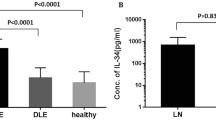Abstract:
The aim of this study was to determine whether the levels of serum cytokines IL-6 and TNFα and of the soluble receptors p55 srTNFα, p75 srTNFα and srIL-2α are valuable markers of disease activity in patients with systemic lupus erythematosus (SLE) compared with the established parameters of anti-dsDNA, C3, C4 and CH50. Forty patients with SLE, 19 ambulatory and 21 hospitalised, were included in this study. On the day of blood sampling a clinical examination was performed and SLEDAI and ECLAM disease activity scores were used to assess disease activity. Nineteen patients had inactive disease and 21 patients had active disease. Thirteen patients from the second group developed nephritis. In these patients the blood sampling and disease activity assessment were performed twice (at presentation and 6 months after treatment). Serum levels of cytokines and soluble receptors were measured by ELISA. Serum levels of cytokines and soluble receptors of patients with active disease were significantly higher than in patients with inactive disease (IL-6 p = 0.0004, TNFαp = 0.0015, srIL-2αp<0.0001, p55 srTNFαp<0.0001, p75 srTNFαp<0.0001). Serum soluble receptor levels of patients with inactive disease were higher than those of healthy controls (p55 srTNFαp<0.0001, p75 srTNFαp = 0.0002, srIL-2αp = 0.0012). No significant difference was found for TNFα and IL-6 (TNFαp = 0.015, IL-6 p = 0.019). Serum TNFα levels and especially srIL-2α, p55 srTNFα and p75 srTNFα levels correlated strongly with SLEDAI and ECLAM disease activity scores, anti-dsDNA, C3, C4 and CH50 (p<0.0001). Serum soluble receptor (srIL-2α, p55 srTNFα, p75 srTNFα) levels were higher in patients with nephritis before treatment and decreased significantly 6 months after treatment (p = 0.005). The same trend was noticed with SLEDAI and ECLAM disease activity scores (p = 0.005) and anti-dsDNA (p = 0.008). In contrast, no significant differences were observed for C3 and C4 levels before and after treatment, which suggests that soluble receptors of cytokines are more sensitive markers of disease activity than C3 or C4 in predicting improvement. Serum levels of srIL-2α, p55 srTNFα and p75 srTNFα could provide useful information about disease activity in SLE patients, especially in cases where the other markers do not.
Similar content being viewed by others
Author information
Authors and Affiliations
Additional information
Received: 3 March 1998 / Accepted: 13 July 1998
Rights and permissions
About this article
Cite this article
Davas, E., Tsirogianni, A., Kappou, I. et al. Serum IL-6, TNFα, p55 srTNFα, p75 srTNFα, srIL-2α Levels and Disease Acitivity in Systemic Lupus Erythematosus. Clin Rheumatol 18, 17–22 (1999). https://doi.org/10.1007/s100670050045
Issue Date:
DOI: https://doi.org/10.1007/s100670050045



